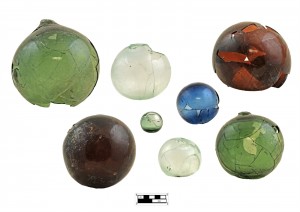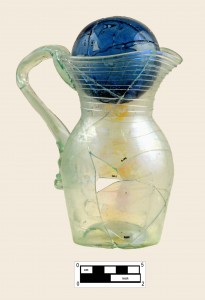November 2011–Artifact of the Month
(Previous) Artifact of the Month Index
Warding Off Evil with Whimsey

Reconstructed witch balls measuring 1.25” — 7” diameter; colors include green, aqua, amber, cobalt, and amethyst. Click for enlargement.
English settlers brought the witch ball tradition with them to the American colonies, and witch balls were locally manufactured by glass works located in the New Jersey and Philadelphia areas as early as 1820. Originally lined with silver, witch balls were thought to work by frightening away evil spirits when they saw their own reflection. Others types of witch balls were made with clear, brightly colored glass, either in a single solid color or swirls of multiple hues. The positive energy associated with the attractive colors of this style was thought to attract negative energy and mesmerize evil spirits, draw the malicious force into the balls, and trap it inside. In the U.S., witch balls were commonly hung on strings in the sunniest rooms of homes or placed in prominent spaces on fireplace mantles. In some instances they also served more practical purposes, and were used as a sort of stopper or cover used to seal open pitchers or bowls, and thereby protect foods and drink from things like dust and insects.
At the height of their popularity, witch balls were sold by street vendors. At some glassworks, they were made as “end-of-day” items, or “whimsies”, after regular daily production quotas had been met. By the 20th century the popularity of witch balls faded in the US, but continued in England until World War II.
Submitted by Erin Broadhurst
by admin
